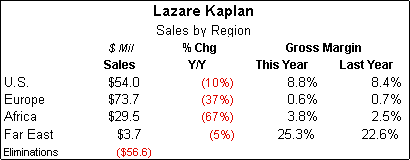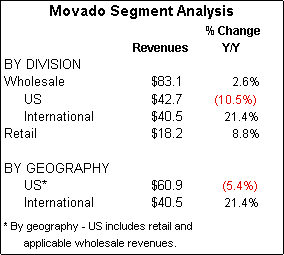IDEX Online Research: Jewelry Suppliers Report Tough First Quarter
August 06, 07
Jewelry suppliers were not immune to the ills that affected jewelry retailers in the first quarter. All three major U.S. publicly held jewelry suppliers reported tough business conditions which resulted in a decline in profits for the period.
While the sample of jewelry suppliers is very small, we believe that a majority of suppliers also experienced the same profit pressures in the first period of the year.
Unfortunately, the reasons for weak results varied considerably by supplier. There was no common thread of reasons that affected sales and margins. But the result was the same: depressed profits.
The following highlights first quarter results for Charles & Colvard, Lazare Kaplan and Movado (non-retail operating divisions).
Charles & Colvard – Sales & Profits Down
Charles & Colvard, which supplies moissanite for jewelry reported a decline in sales and profits in the three-month period ended March 2007. Corporate revenues declined by 28 percent, including both U.S. and international sales.

- U.S. sales represented about 79 percent of Charles & Colvard’s total first quarter revenues. U.S. sales were just under $4.6 million, a decrease of 35 percent from the prior year. Carat shipments of moissanite to U.S. customers were down 32 percent in the quarter. Four factors hurt demand:
- A lack of new customers purchasing their initial inventory.
- A reduction of television home shopping broadcast hours.
- Landau Jewelers reduced the number of stores selling moissanite jewelry.
- Lack of restocking by jewelers related to weaker-than-expected sales of moissanite in the fourth quarter of 2006.
- The company’s gross margin rose to 76.7 percent from last year’s 73.7 percent due to two factors:
- Lower production costs related to the company’s FIFO accounting.
- The increase in the gross margin was offset slightly by a 2 percent decrease in the price per carat sold.
· Charles & Colvard’s marketing and selling expenses soared in the quarter, both on a dollar basis as well as a percentage of sales.
o Marketing and selling expenses rose to $2.7 million versus $2.5 million in the same quarter last year.
o As a percentage of sales, marketing and selling expenses rose to 46.3 percent of sales from 31.4 percent last year.
o Increased compensation costs drove some of the increase in marketing expense.
o Increased advertising, offset somewhat by decreased co-op advertising, contributed to higher marketing and selling costs.
o Market research costs were reduced in the quarter.
· The company’s pretax margin was 13.1 percent this year, down dramatically from 31.7 percent last year. Virtually every cost category, including marketing, general, administrative, research & development, and interest expense, rose as a percentage of sales.
· Charles & Colvard’s reported inventory fell by almost 20 percent in the quarter. However, this was mostly the result of a reclassification of certain inventory to long term assets at the end of the quarter. Inventory on consignment was about flat at $2.2 million, year-over-year.
· The company has no debt on its balance sheet.
· The outlook remains solid for Charles & Colvard, in our opinion.
o Consumer awareness of moissanite reached 10.5 percent in January 2007, up from 7.8 percent a year ago.
o Kohl’s has agreed to put moissanite in all 700+ of its stores, up from the current 279 units.
o Sears will sell moissanite in just over 140 units by this summer, up from the current 20 test units.
o The company plans to add another jewelry manufacturer to its short list of moissanite jewelry producers.
o Management reported that it is making some progress in overseas markets, but it did not quantify this progress, other than via the sales numbers. In the first quarter, international sales were roughly $1.2 million, up nearly 28 percent over the same period a year ago.
o Total annual sales in 2007 should be in the $45-48 million range for Charles & Colvard, up from last year’s $40.7 million. Thus, subsequent quarterly revenues, especially in the second half, are expected to show strong positive comparisons.
Lazare Kaplan – Sales & Profits Down
For its third fiscal quarter ended February, Lazare Kaplan, the diamond supplier, reported a sharp decline in both sales and profits.

· While Lazare Kaplan is following the “letter of the law,” it is not particularly forthcoming with its explanations about what happened in the quarter. Maurice Tempelsman once accused the industry of being “veiled in secrecy.” Some of us think that might apply to the company’s February quarterly financial results.
· Management said rough diamond sales declined sharply because of a transfer of formal sector Angolan rough diamond buying and trading operations to a formal joint venture which the company accounts for using the equity method. Here’s what this statement, taken directly from the company’s legal filing, means: 1) the equity method means the company books the profit or loss from the joint venture, but does not report sales or other costs related to the business venture. But the company did not quantify the amount of diamond sales that were transferred, nor did it adequately explain why it changed accounting methods, in our opinion.
· Lazare Kaplan also said that its rough diamond revenues include $1 million received in connection with certain sourcing and financing initiatives. Again, there was no further explanation of this revenue item.
· Sales across every region of the world were down for Lazare Kaplan. The U.S., which is one of the company’s major markets, posted a sales decline of about 10 percent, the smallest decrease of the three major regions. The table below summarizes sales and gross margin by region.
 |
· As a percentage of sales, the company’s corporate gross margin rose to 7.0 percent of sales from the prior year’s 5.6 percent.
o The company’s rough gross margin rose to 4.4 percent from 2.9 percent last year due to two factors: 1) improving market conditions; and, 2) a reduction in allocated costs related to a change in accounting for its Angolan operations.
o The company’s polished diamond margin fell to 12.0 percent from last year’s 14.6 percent due to a shift in sales mix to fine cut diamonds which carry an inherently lower margin than branded diamonds. In addition, the company was unable to pass along higher rough diamond prices in its commercial polished diamond production operation. Finally, the decreased polished diamond margin relates to reduced revenue and margins from the company’s laser inscription fees. The company is in litigation over its laser inscription business which it views as proprietary.
o The company’s total gross margin rose because of a higher mix of polished diamond sales which carry an inherently higher margin than rough diamonds. This year, polished diamond sales were almost 34 percent of revenues versus 23 percent last year in the February quarter.
· Lazare Kaplan’s operating expense ratio rose to 5.5 percent of sales from 4.5 percent last year.
o Three factors affected the company’s expense ratio.
§ Litigation costs related to protecting its intellectual property rights (laser inscription) were higher.
§ Salaries were lower.
§ There was a one-time credit of $1.2 million in operating costs. On a normalized basis, the company’s operating cost ratio would have been 6.9 percent of sales this year, far higher than the reported 5.5 percent. We are unclear if this credit may be related to the $1 million of revenues related to “certain sourcing and financing initiatives.”
o As a result of a slightly higher gross margin, but much a higher operating cost ratio, Lazare Kaplan’s pretax margin was 0.1 percent of sales (one-tenth of one percent), down from last year’s 0.5 percent (one-half of one percent) of sales. Clearly, the company’s profit margins are under siege.
· Total inventories dropped by about 6 percent, with rough diamond inventories down 37 percent, and polished diamond inventory down 2 percent. The sharp decline in rough inventories relates to the change in accounting for the company’s Angolan operations.
· The company’s debt levels as a percentage of capitalization dropped modestly to 54.3 percent from the prior year’s 56.9 percent.
· Management does not customarily provide financial guidance. However, it noted that conditions remain challenging, and short term unfavorable financial comparisons are likely to continue.
Movado
Total corporate revenues at Movado were $101.4 million, up 3.7 percent. Excluding one-time liquidation sales, revenues would have been up about 0.9 percent (nine-tenths of one percent).

About 82 percent of Movado’s revenues are related to its watch production, marketing and distribution operations. Wholesale operations generated $83.1 million in sales in the quarter. Unless otherwise noted, the following comments relate to the company’s wholesale watch segment.
· Wholesale sales rose by 2.6 percent in the quarter ended April 2007.
o U.S. wholesale sales declined by 10.5 percent in the period.
o International wholesale sales rose by 21.4 percent in the quarter.
· During the quarter, the company generated $2.7 million in liquidation sales, an event which did not occur last year. If liquidation sales are removed, the company’s wholesale sales were down about 1 percent.
· The following table summarizes sales by division for the first quarter.
 |
· The primary reason for weak U.S. wholesale sales was lower sales in the Movado’s “accessible luxury” brands – Movado and ESQ – due to a shift in the retail calendar: retailers pushed their receipt of those goods into the second quarter. Sales in the accessible luxury category included $1.3 million of discontinued merchandise.
· Net sales in the “luxury” category of Movado’s brands – Ebel and Concord – were essentially flat. Excluding sales of discontinued merchandise in this category, luxury brand sales were down 12 percent.
· Licensed brands – Tommy Hilfiger, Hugo Boss, Juicy Couture, Coach and LaCoste – were about flat in the U.S. in the quarter.
· The reported corporate gross margin declined very modestly to 60.8 percent of sales from 61.0 percent last year. However, excluding the below-average gross margin associated with liquidated inventory, the company’s overall gross margin would have been 62.9 percent, well above last year’s levels. Three factors are driving the company’s underlying gross margin higher.
o Increased margins on new products.
o Increased margins in the Movado stores.
o Changes in the merchandise mix.
· As a percentage of sales, operating costs raised to 58.1 percent from last year’s 57.5 percent due to several factors, including higher equity-based compensation, retail expansion and increased spending on customer service.
· The company’s pretax margin was 3.1 percent in this year’s first quarter versus 3.5 percent in the same quarter last year. A decline in the gross margin and an increase in operating expenses took their toll on pretax profits.
· Movado’s inventory fell by nearly 1 percent during the quarter. Management is highly focused on asset management and wise use of its cash flow.
· Movado’s total debt to capitalization declined to 17.0 percent this year from last year’s 23.9 percent. Long term debt is down substantially.
· The company noted that, similar to the first quarter, shipments that would normally occur in the second quarter will occur in the third quarter, due to a calendar shift.
· Total revenues for the year are expected to be in the range of $550-560 million, for a modest gain of about 4-5 percent.